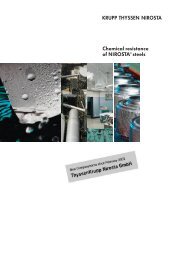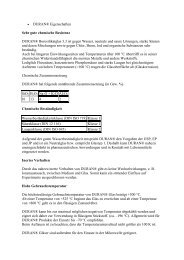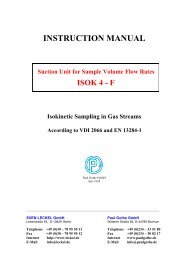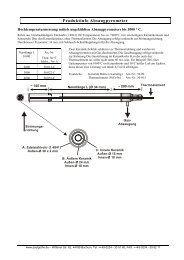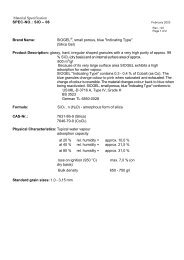Product Information Chemical Resistance Chart - Paul Gothe GmbH
Product Information Chemical Resistance Chart - Paul Gothe GmbH
Product Information Chemical Resistance Chart - Paul Gothe GmbH
You also want an ePaper? Increase the reach of your titles
YUMPU automatically turns print PDFs into web optimized ePapers that Google loves.
<strong>Product</strong> <strong>Information</strong> <strong>Chemical</strong> <strong>Resistance</strong> <strong>Chart</strong>, Version 04/00<br />
2. Interpretation of symbols + material little or not affected by chemical: suitable<br />
O various attack grades depending on conditions:<br />
limited suitability<br />
- material shows severe attack: unsuitable<br />
This guide assumes in the most cases a temperature of 20°C<br />
(68°F). The chemical resistance of materials decreases generally<br />
with increasing temperature.<br />
If the chemical resistance of a material changes from good to poor<br />
depending on the operating conditions (temperature, pressure) or<br />
on the concentration and purity of the chemical then the rating O will<br />
be given.<br />
3. References All the information quoted in these resistance tables is based on<br />
industrial experience (for example „DECHEMA -Werkstoff-Tabelle“,<br />
Germany or „DECHEMA Corrosion Handbook“) and data of the<br />
material manufacturers.<br />
<strong>Chemical</strong> <strong>Resistance</strong> Tables<br />
The following chemical resistance tables are devided into three<br />
categories, standard chemicals, commercial products and liquid<br />
foods and beverages.<br />
Materials used seldom in our products (e.g. aluminium) are not<br />
described in detail in the tables. In such cases, chemical resistance<br />
information related to a particular application or product should be<br />
requested. The same applies to nickel-plated and chromium-plated<br />
components. If no special note, please use table for 1.4305.<br />
The materials PTFE (Teflon) and epoxy resin are also excluded.<br />
Both are resistant to most common chemicals and can thus be<br />
employed in the majority of applications. <strong>Chemical</strong>s to which these<br />
materials are not resistant are mentioned in the following summary.



